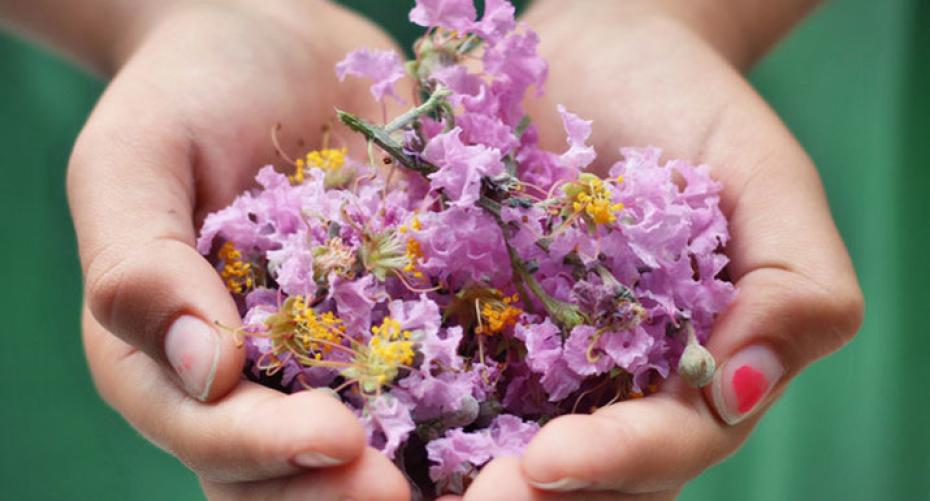Make your garden a safe haven where kids can play and grow their own vegs
Engaging your child with the natural world is becoming more important than ever, as in this technological world we are becoming more and more distanced from nature, the elements and from taking even a modest amount of exercise. Engaging your child in the natural wonders of the garden can lead them to also becoming curious about the great outdoors. The garden also needs to be a safe environment where your child can play without constant supervision, but this is quite easily achieved with a few common sense precautions.
If you have a long thin garden put a path from one end to the other to enable them to ride their bike, skateboard or rollerblade in safety. Avoid using gravel paths as you can’t ride your bike on them and they are incredibly painful if you take a tumble. A grassy patch or bark mulch used in a play area also provides a soft landing. If you only have concrete consider investing in some rubber matting to make a fall less likely to end in tragedy. If you have a sandpit make sure it is covered so that cats can’t use it as a toilet. If you have decking in the adults area it can become incredibly slippery, not only for children, so consider covering it with stone, non-slip tiles, they are also more hardwearing and require less maintenance.
Making small raised beds gives them the opportunity to grow their own vegetables, if they grow them they are more likely to eat them. There are quite a lot of small vegetables to grow, such as radish, baby carrots, small beans and peas are always a favourite. A trip to a garden centre seed department will give you lots of ideas for things to try. Intersperse the vegetables with some flowers to make the plot look attractive and they are more likely to keep it tended and looking nice. You can also make their plot look nice by making a scarecrow, make some bunting to hang around, paint the raised beds in bright colours or if they don’t have raised beds put some low board fencing around their area and paint this instead. If growing things in containers buy the cheap plastic ones from the pound shop and paint these.
Keeping an area for wildlife will give them plenty of opportunity to go bug hunting, make a bat roosting house out of old bits of timber and a hedgehog house out of cardboard boxes. Put up a bird box and insert a nest cam so they can watch from the house if the weather is too rough to play outside. Also hang up some bird feeders where they can also watch the wildlife from the house; just make sure they are not near anywhere a cat can hide and pounce. Another project is to make an insect hotel by cutting hollow canes or plant stems to even lengths, tying them together in a bundle and hanging them in a tree or placing them in an out of the way spot.

A small pool in the wildlife area also attracts a lot of wildlife but make sure it is covered with a mesh to stop children falling in as you can drown in just a couple of inches of water. The mesh holes need to be large enough for small mammals to get through for a drink and make one side shallow with stones going into the water so that the animals can enter and exit easily. This also goes for any fountains or other water features you may have in the garden. Plant some butterfly friendly plants so that children can record and draw any they see. You can also incorporate a Fairy Garden in the wildlife area.
Providing plenty of interest in the garden will be more likely to engage a child’s curiosity, but equally important is proving a sheltered hidey hole where they can sit and read or use a tablet. A living willow structure is easy to make, all you have to do is stick the branches into the ground and they will root quite quickly; when they grow large enough weave the ends together to form a roof.

Willow maze at Levens Hall, Cumbria
Check on the internet that the plants you have in the garden are not toxic; poisoning is very rare but not impossible so it’s better to be safe than sorry. Also make sure the garden gate is locked and the lock out of reach; and that there are no gaps in the fence that a little person can wriggle through. You can also create different zones in the garden where the adult parts are out of bounds to children and fenced off with plants, trellis or screens and a locked gate.
You don’t need to spend a fortune on dedicated play equipment, which they are going to grow out of in a couple of years anyway. Try tying an old tyre or a thick knotted rope to a sturdy tree branch, make sure the tree is healthy and the branch not likely to snap. Don’t forget mature trees are also the perfect place to build a den or provide a shady play area on a hot day.
Finally don’t forget to spend some time with your children in the garden and teach them about the plants, what they can and can’t do and just enjoy your time with them. If you only have a small garden and don’t have the space to make dens, a football pitch or a place to ride the bike there’s always a walk in the countryside.




![Kingsbury-bench-05[1].jpg](http://www.hayesgardenworld.co.uk/cdn/shop/files/Kingsbury-bench-05_5B1_5D.jpg?v=1712162737&width=1500)
![Kingsbury-bench-01[1].jpg](http://www.hayesgardenworld.co.uk/cdn/shop/files/Kingsbury-bench-01_5B1_5D.jpg?v=1712161065&width=1500)
![tw17a-4947_0[1].jpg](http://www.hayesgardenworld.co.uk/cdn/shop/files/tw17a-4947_0_5B1_5D.jpg?v=1715609205&width=1500)
![tw17a-4947_tenbury_5ft[1].jpg](http://www.hayesgardenworld.co.uk/cdn/shop/files/tw17a-4947_tenbury_5ft_5B1_5D.jpg?v=1712161172&width=1500)
![tw17a-4952_tenbury_4ft[1].jpg](http://www.hayesgardenworld.co.uk/cdn/shop/files/tw17a-4952_tenbury_4ft_5B1_5D.jpg?v=1712161034&width=1500)
![thumbnail_IMG_1565-kik_2[1].jpg](http://www.hayesgardenworld.co.uk/cdn/shop/files/thumbnail_IMG_1565-kik_2_5B1_5D.jpg?v=1712226536&width=1500)
![thumbnail_IMG_1565-kik_1[3].jpg](http://www.hayesgardenworld.co.uk/cdn/shop/files/thumbnail_IMG_1565-kik_1_5B3_5D.jpg?v=1712159637&width=1500)



![WD-XgESA[1].jpeg](http://www.hayesgardenworld.co.uk/cdn/shop/files/WD-XgESA_5B1_5D.jpg?v=1712159609&width=1500)